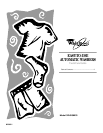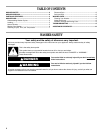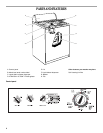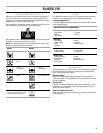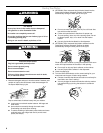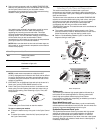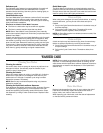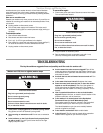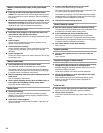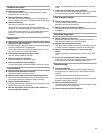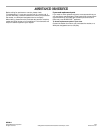
10
Washer continues to fill or drain, or the cycle seems
stuck
■ Is the top of drain hose lower than the water level in
washer? The top of the hose must be higher than the water
level in the washer for proper operation. See the Installation
Instructions.
■ Does the drain hose fit too tightly in the standpipe, or is it
taped to the standpipe? The drain hose should be loose yet
fit securely. Do not seal the drain hose with tape. The hose
needs an air gap. See the Installation Instructions.
Washer won’t drain or spin
■ Is the drain hose clogged, or the end of the drain hose
more than 72" (183 cm) above the floor?
See the Installation Instructions for proper installation of drain
hose.
■ Is the lid open?
The lid must be closed during operation. Washer will not
agitate or spin with the lid open.
■ Is there excessive sudsing?
Always measure detergent. Follow manufacturer’s directions.
If you have very soft water, you might need to use less
detergent.
■ Is your voltage low?
Check your electrical source or call an electrician. Do not use
an extension cord.
Washer makes noise
■ Is the load balanced, and is the washer level?
The wash load should be balanced and not overloaded.
The washer must be level. The front feet should be properly
installed and the nuts tightened. Reset the rear leveling legs
(if needed). See the Installation Instructions.
■ Did you completely remove the yellow shipping strap with
cotter pins?
See the Installation Instructions.
■ Are the gears engaging after the drain and before spin, or
is the upper part of agitator clicking during wash?
These are normal washer noises.
Washer leaks
■ Check the following:
Are the fill hoses tight? Are the fill hose washers properly
seated? Is the drain hose clamp properly installed? See the
Installation Instructions.
■ Is the sink or drain clogged?
Sink and standpipe must be able to handle 17 gal. (64 L) of
water per minute.
■ Is water deflecting off the tub ring or the load?
Center the tub before starting the washer.
The wash load should be balanced and not overloaded. The
fill or spray rinses can deflect off the load.
The washer must be level. The front feet should be properly
installed and the nuts tightened. Reset the rear leveling legs
(if needed). See the Installation Instructions.
■ Check household plumbing for leaks.
Washer basket is crooked
■ Was the washer basket pulled forward during loading?
The wash load should be balanced and not overloaded. Push
the basket to the center before starting wash.
■ Is the load balanced, and is the washer level?
The wash load should be balanced and not overloaded.
The washer must be level. The front feet should be properly
installed and the nuts tightened. Reset the rear leveling legs
(if needed). See the Installation Instructions.
■ The washer basket moves while washing.
This is normal.
Agitator operation
■ The top of the agitator is loose, or moves in only one
direction.
This is normal.
Dispensers clogged or bleach leaking
■ Did you follow the manufacturer’s directions when adding
detergent and fabric softener to the dispensers?
Measure detergent and fabric softener. Slowly pour into the
dispensers. Wipe up all spills.
Dilute fabric softener in the fabric softener dispenser.
■ Did you put powdered or color-safe bleach in the liquid
chlorine bleach dispenser?
Add powdered or liquid color-safe bleach directly to the
basket. Do not use the chlorine bleach dispenser for
color-safe bleach.
Load too wet
■ Did you use the right cycle for the load being washed?
Select a cycle with a higher spin speed (if available).
■ Did you use a cold rinse?
Cold rinses leave loads wetter than warm rinses. This is
normal.



